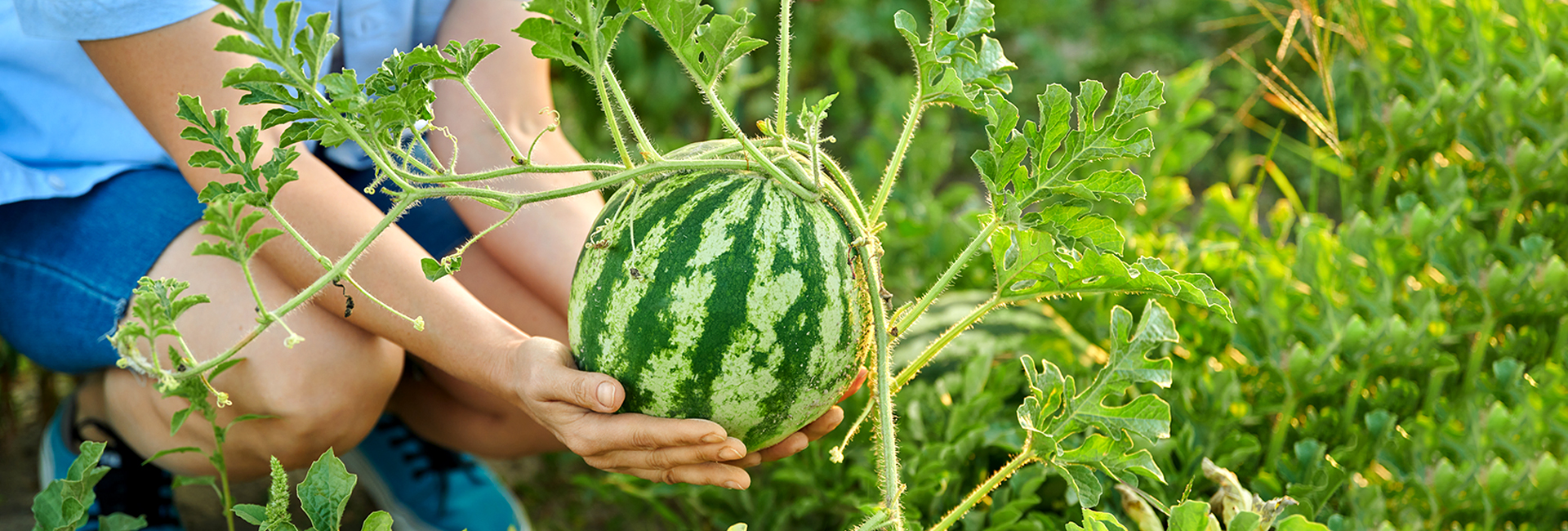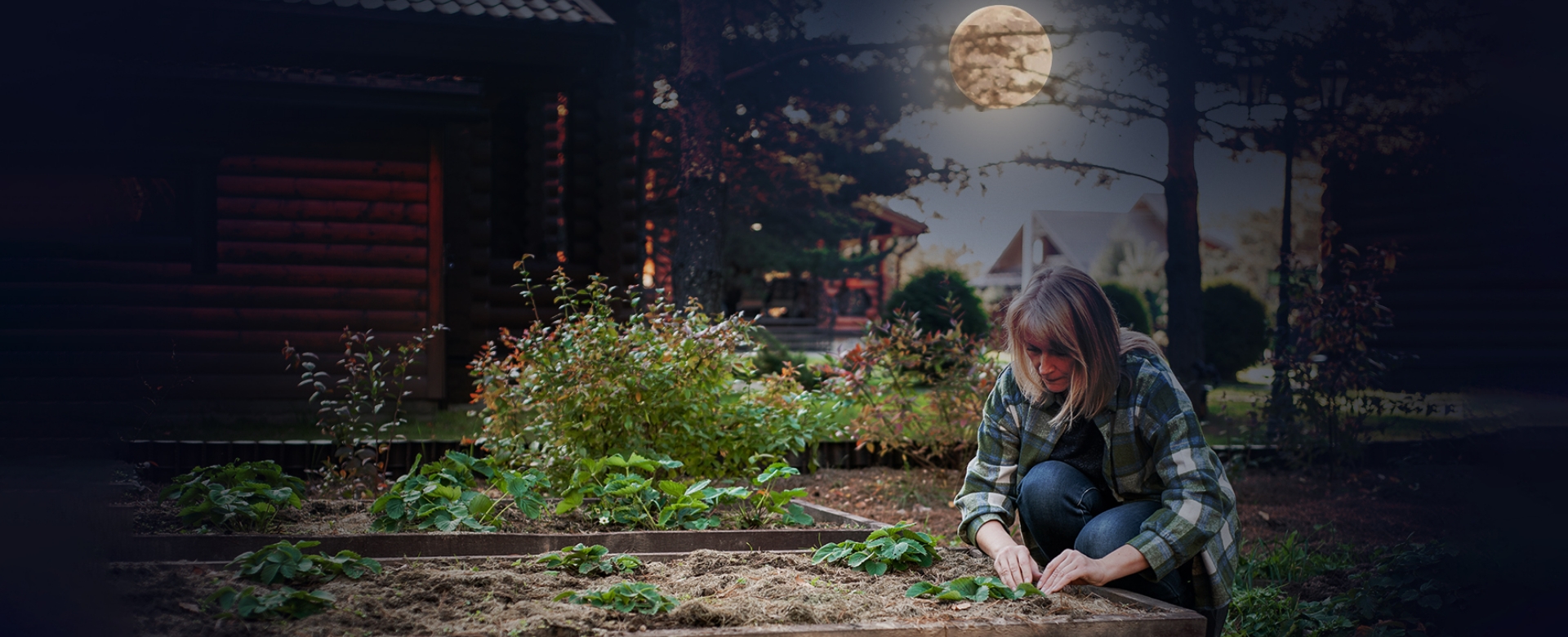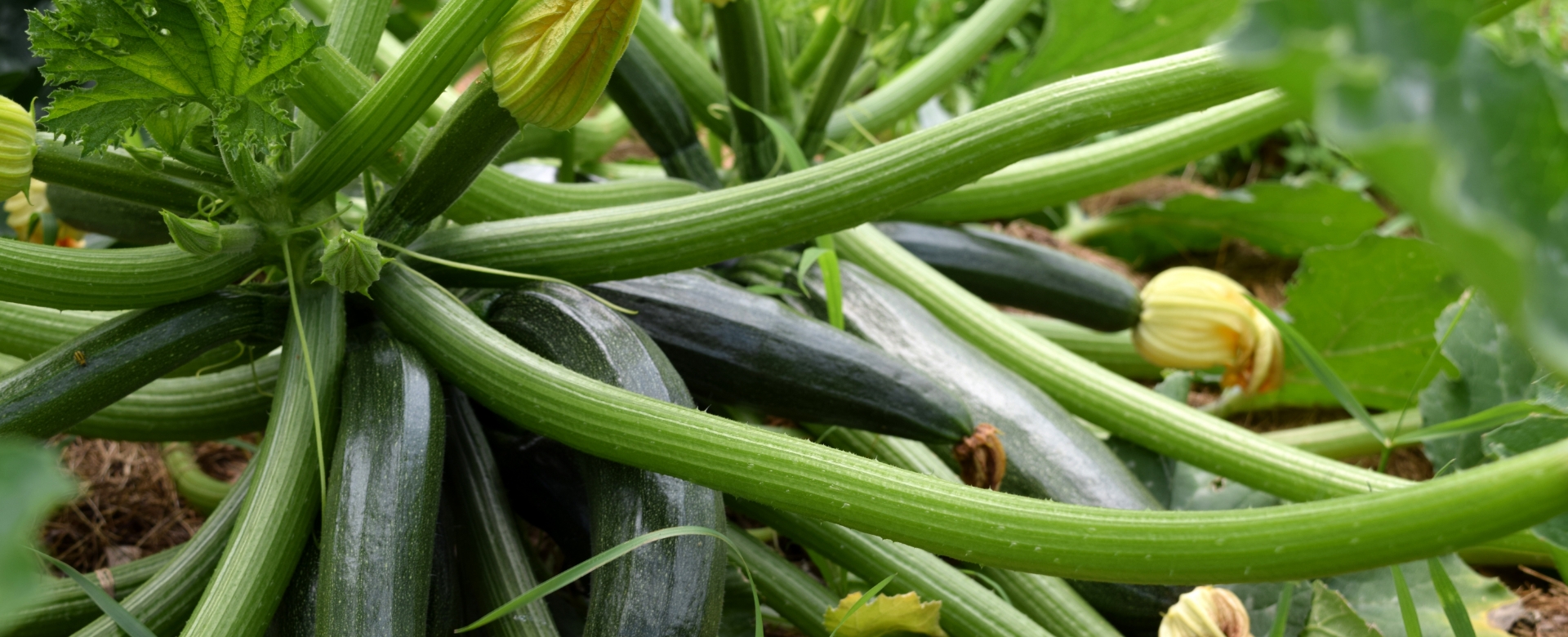Are you one of those struggling gardeners who have trouble getting the melons to produce before the arrival of cool fall weather?
Well, if you are, send your worries packing.
Companion planting can make your job easy. It can help the watermelon patch in your garden get proper pollination and avoid pests.
So, what grows best near watermelons? We’ve compiled the best (and worst) companion plants for watermelons to sail you through. We also have some tips and tricks for your planting success that you’ll want to implement immediately.
What are Watermelon Companion Plants?
Crops that help each other grow well together. That’s the gist of this technique. Watermelon companion plants include vegetables, flowers, and herbs that’ll sync well with watermelons. They enhance soil health, provide shelter and shade from wind, deter diseases, repel dangerous insects and draw favorable ones, and suppress weeds. This beneficial ecosystem can also be established when you want to grow your watermelons in containers.
Benefits of Companion Planting for Watermelons
- Boosted pollination: Flowering companions like marigolds and nasturtiums attract bees and other pollinators. These beneficial insects help transfer pollen between male and female watermelon flowers, leading to a higher fruit set, and ultimately, more watermelons!
- Pest deterrence: Strong-smelling herbs like mint and basil can repel some harmful insects with their aroma. This reduces the need for harsh pesticides and creates a more natural ecosystem for your watermelons.
- Improved soil health: Certain companion plants, like legumes such as beans, can fix nitrogen in the soil. This enriches the soil and benefits your watermelons by providing them with essential nutrients for growth.
- Enhanced flavor: While research isn’t conclusive, some gardeners believe certain companion plants can subtly influence the flavor of watermelons. For example, herbs like nasturtiums might add a slightly peppery note.
Best Watermelon Companion Plants

Here are the 7 best watermelon companion plants that you should grow near watermelons.
1. Marigolds
Pollination by bees for a successful watermelon crop is a must. And marigold is one such plant that attracts bees which helps with watermelon pollination. Additionally, marigolds naturally deter pests like whiteflies, nematodes, and aphids, which are detrimental for watermelon plants.
2. Nasturtiums
Nasturtiums are a fast-growing annual plant with colorful edible flowers that naturally repel dangerous squash bugs, whiteflies, and aphids. Nasturtiums also draw beneficial bugs like beetles. If they are placed near watermelons, it can create a natural pest obstacle, minimizing the need of chemical interventions.
3. Dill
Dill is another fast-growing annual herb with fluffy leaves and yellow flowers, attracting parasitic wasps and ladybugs who love eating aphids. Better watch out, aphids! This makes dills an overall better choice to be planted next to watermelons.
4. Beans
Beans are a type of legume plant known for being “nitrogen fixers”. They suck nitrogen from the air and reserve it in their roots, then pass it along to the soil when they decompose. Nitrogen naturally enriches the soil. This is beneficial for watermelons because they are heavy feeders.
5. Radishes
Radishes are a flowering plant in the mustard family with a spicy tang that deters cucumber beetles and aphids. Radishes can also assist in breaking up the compacted soil. As a reward, radishes are all set to harvest before watermelons need their space.
6. Corn
Watermelons and corn share almost the same pest problems as aphids and thrips, this can cause more pest pressure if you’re not attentive and don’t take preventive measures. This is one of the reasons why you should include plants that repel the same insects and bugs.
7. Borage
Borage, also known as starflower, is an annual herb with hairy leaves. It attracts pollinators like bees, which are essential for a watermelon fruit set. Additionally, Borage also helps with the soil enrichment and deter tomato hornworms.
Bad Watermelon Companion Plants

1. Cucumbers
Cucumbers share the same cucurbit family tree as watermelons. Both gobble up similar nutrients from the soil, setting off your watermelons struggling for growth. Additionally, these green fellows draw the same pests, putting your watermelons in harm’s way.
2. Squash
Squash plants sprawl wildly and cast huge shadows. That’s a big no-no for sun-loving watermelons. After all, who would want to fall prey to a shady scheme, right? Watermelons, for one, absolutely don’t. On top of it, they also share the same vulnerability to pests.
3. Pumpkins
Pumpkins, while a lovely fall treat, are noisy neighbors for watermelons. Both are susceptible to the same set of diseases, like fungal wilt and powdery mildew. Planting them together can create chaos, where a disease outbreak on pumpkins can quickly destroy your watermelon patch.
4. Potatoes
Watermelons thrive with extensive root systems that need plenty of space to spread underground. Enter potatoes with their shallow root networks. Planting potatoes near watermelons creates an underground competition for space and nutrients.
5. Cantaloupes
Just like cucumbers, cantaloupes also belong to the cucurbit family, which makes them the shared target of similar diseases. Planting them close together increases the risk of cross-contamination, potentially wiping out both your watermelons and cantaloupes.
Watermelon Companion Planting Tip for Success
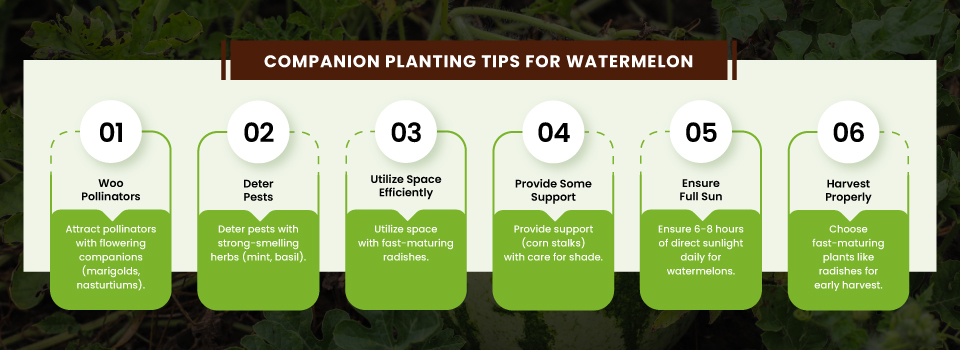
- Woo pollinators: Plant flowering companions like marigolds, nasturtiums, or dill to attract bees and other beneficial insects.
- Deter pests: Strong-smelling herbs like mint or basil can help deter some harmful insects with their aroma.
- Utilize space efficiently: Plant fast-maturing radishes that can be harvested before the watermelon vines sprawl. They can also act as a trap crop for pests.
- Provide some support: Corn stalks can offer climbing watermelons some support and protection from wind and sun.
- Ensure full sun: Watermelons are sun-loving plants. Watermelons need a bare minimum of 6-8 hours of sun light every day. So, choose the spot wisely for your watermelons.
Common Mistakes to Avoid
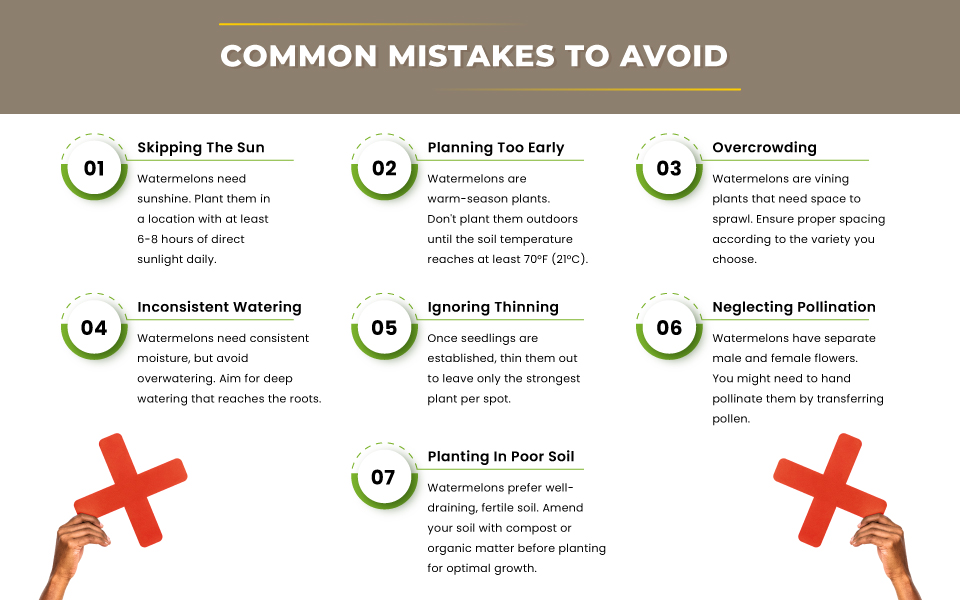
Want a thriving watermelon crop? Don’t make these mistakes.
1. Skipping the sun
Watermelons are sun worshippers! Skip the shady corners and choose a location bathed in at least 6-8 hours of direct sunlight daily. This vital sunshine fuels their growth and sweetens those delicious melons.
2. Planting too early
Watermelon enjoys warm weather. If you plant it too early (late spring), before temperatures have warmed up, the plant will grow slowly and may not fully make it. Instead, grow under cover or wait until overnight temperatures are decently warm.
3. Overcrowding
Watermelons are all about sprawling vines. Don’t crowd them or other plants! Choose the right spacing based on the variety you pick. Think of it as giving your watermelon plenty of room to breathe and sprawl for maximum fruit production.
4. Inconsistent watering
Watermelons crave consistent moisture, but don’t drown them! Aim for deep watering that reaches the roots, allowing the soil to dry slightly between drinks. This prevents waterlogging and encourages healthy root development.
5. Ignoring thinning
When starting from seeds, you might plant a few per spot. But don’t let them compete! Once seedlings are established, select the strongest plant and gently remove the others.
6. Neglecting pollination
If you do not see a fruit set, it might be a pollination problem. These shy flowers need a little help! You can help by gently transferring pollen from male flowers to female flowers with a cotton swab.
7. Planting in poor soil
Watermelons crave well-draining, fertile soil. Don’t plant them in a barren wasteland! Amending your soil with compost or organic matter before planting provides the nutrients and drainage these thirsty vines crave for optimal growth.
Conclusion
With a little planning and these amazing tips in your back pocket, you can avoid common mistakes and cultivate a bountiful watermelon patch. So, grab your seeds, get your soil ready, and prepare to savor the rewards of your summertime gardening efforts.
On the off chance, if you are looking for organic gardening supplies, visit our Homegrown Outlet near you in Upstate New York.
FAQs
Watermelons are vining plants and require ample space. Depending on the variety, they can spread 3-6 feet in all directions. Ensure proper spacing when planting according to the specific variety you choose.
While not essential, rotating companion plants in your container or garden bed can be beneficial. This helps prevent soil depletion of specific nutrients and reduces the chance of certain diseases building up in the soil over time.
There is a combination of factors that can help you determine the ripeness of watermelons. Look for a dull green rind that loses its shine. The tendril closest to the stem should be brown and dry. When thumped gently, a ripe watermelon should sound hollow.
Watermelons have separate male and female flowers. If you're not seeing fruit set and have limited natural pollinators, you might need to hand-pollinate them by transferring pollen from male flowers to female flowers with a cotton swab.

